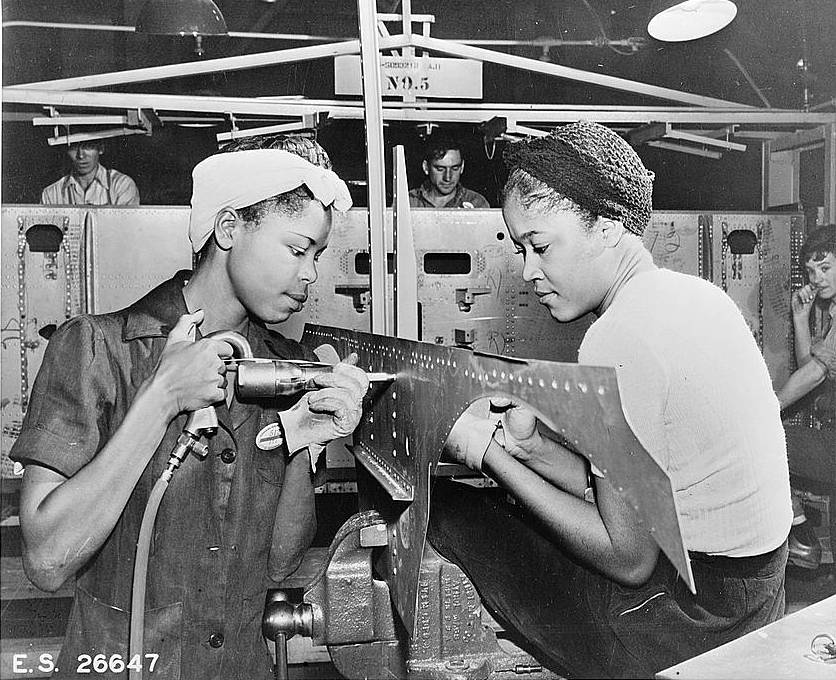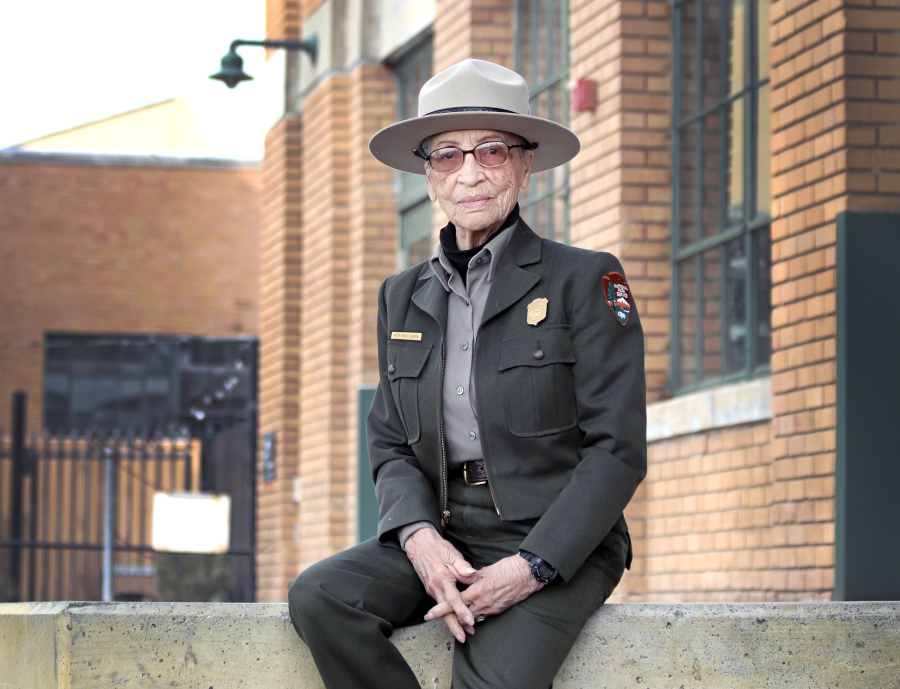By Robert Tate, Automotive Historian and Researcher
Images Courtesy of the US Office of War Information, Tamiment Library NYU, The National WWII Museum, National Park Service photo/Luther Bailey and many others
Published 2.15.2023
 African American Rosies (Tamiment Library NYC)
African American Rosies (Tamiment Library NYC)
As MotorCities continues observing Black History Month, here is a story about the contributions of African American women during World War II. Recognizing the women who stepped into various industrial jobs, “Rosie the Riveter” became a popular icon after the production of famous government poster in 1943. Most of the women who worked during this historic time did it in segregated workplaces. About 600,000 Black women left their other jobs to join the war effort working in defense plants.
 Clara Doutly (ClickOnDetroit.com)
Clara Doutly (ClickOnDetroit.com)
One local Rosie the Riveter who just celebrated her 101st birthday is Clara Doutly. She was born on October 21, 1921 in Detroit and is still with us today. For many years, Doutly worked hard and helped move this country forward during the World War II. She attended Cass Technical High School in Detroit but ended up forgoing her studies to work in auto supplier Briggs Manufacturing’s plant during the war. Doutly worked 10 hours a day and ignored the unpleasantness of the job. During her free time, she enjoyed going to Belle Isle Park with her friends to enjoy conversation and the beautiful landscape. On the occasion of her 100th birthday, Doutly was presented with the “Tuskegee Airman” National Museum challenge coin by Larry Sargent. This award is given to special individuals as a token for their efforts to help win the war.
 Clara Doutly (center) with Congresswoman Debbie Dingell celebrating her 101st birthday (Detroit Free Press)
Clara Doutly (center) with Congresswoman Debbie Dingell celebrating her 101st birthday (Detroit Free Press)
Historians have noted that 49 percent of the women employed to help with the war effort as of March 1944 had never worked outside the home. In 1944, the UAW formed the Women’s Bureau, which was devoted to helping women, including African Americans, find jobs in the plants. Many African American women were not trained as mechanics or technicians but as government inspectors and janitors, assembly line workers, clerks and other jobs. These jobs would help them gain great work experience that would be important for their future endeavors after the war.
 African American Rosies (E.F. Joseph Anthony Potter Collection)
African American Rosies (E.F. Joseph Anthony Potter Collection)
After the war, many women, including African Americans, were let go to provide jobs for men returning from combat. Most of the women used the experience gained from working in the automotive factories to further their careers by enrolling in various education programs or colleges and moving into different fields.
 An African American Rosie (University History Archives Collection)
An African American Rosie (University History Archives Collection)
Another very important Rosie the Riveter, still going strong at 100 years of age, is Betty Reid Soskin. During World War II, after graduating from Castlemont High School in Oakland, California, Soskin worked as a file clerk starting when she was 20 years old at a segregated union hall called “Boilermaker’s A-36.” After the war, Soskin and her husband created one of the first black-owned music stores in the country. Later, she would serve as an assistant to a member of the Berkeley City Council and then for two members representing West Contra Costa County in the California State Assembly.
 Black Women at work during World War II (Getty Images)
Black Women at work during World War II (Getty Images)
In the early 2000s, Soskin participated in planning meetings with the City of Richmond and the National Park Service (NPS) to help create the general management plan for the Rosie the Riveter/WWII Home Front National Historical Park. She worked with NPS on a grant to discover untold stories of African-Americans on the Home Front during WWII, which led to a temporary position working for NPS at the age of 84. In 2007, Betty became a permanent NPS employee and led public programs and shared her personal experiences at the park visitor center until her retirement in 2022.
 African American Rosie (National World War II Museum)
African American Rosie (National World War II Museum)
Betty said upon her retirement: “To be a part of helping to mark the place where that dramatic trajectory of my own life combined with others of my generation, will influence the future by the footprints we’ve left behind has been incredible."
 National Park Ranger Betty Reid Soskin (National Park Service/Luther Bailey)
National Park Ranger Betty Reid Soskin (National Park Service/Luther Bailey)
All of the Rosie the Riveters who were a part of our wartime efforts left their positive footprints for the generations to come to follow.
Bibliography
Pamplin, Tim. “Real Life Rosie the Riveter Clara Doutly Celebrates 100th Birthday.” ClickOnDetroit.com, October 21, 2021.
Cabansag, Ronia. “Ypsilanti Rings a Bell for Rosie the Riveter. September 7, 2022.
Lewis-Colman, David M. “Race against Liberalism: Black workers and the UAW in Detroit.” University of Illinois Press, Chicago, 2008.
Fleming, Chandra. “WWII American Rosie the Riveter Association hosts a Birthday Celebration.” Detroit Free Press, October 20, 2022.
National Park Service, Office of Communications. “100-year-old National Park Service Ranger Betty Reid Soskin Retires after Remarkable Career.”



